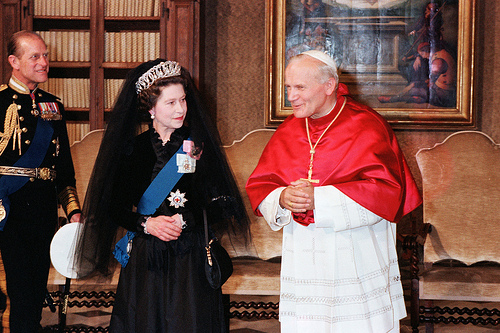
Queen Elena of Italy and Princess Maria José, both with the privilège du blanc, during the visit of Pope Pius XII at the Quirinale.
St. Thomas Aquinas teaches that God filled Creation with inequalities as the best way to reflect His infinite perfections. Creation’s immense variety, ordered in hierarchical fashion, helps men love God more profoundly—this love being man’s ultimate end.

Pope John Paul I meeting Grand Duke Jean and Grand Duchess Joséphine-Charlotte of Luxembourg, September 1978.
Thus, it is perfectly understandable that the Catholic Church would help inculcate an appreciation and admiration for inequalities, including social ones. And we saw an example of this in Pope Francis I’s recent inaugural Mass, when some royal personages wore a white dress and Spanish mantilla, while others wore the traditional black dress and mantilla.
In wearing white on March 19, 2013, Queen Paola of Belgium and Grand Duchess Maria Teresa of Luxembourg made use of what is called the privilège du blanc [the privilege of white]. This honor of wearing a white dress and matching mantilla in the presence of the Vicar of Christ, groups the queens and princesses to whom it has been given in a class of their own, a class that is higher than that of other royalty.

Queen Elizabeth II and The Duke of Edinburgh were received in private Audience by His Holiness Pope John Paul II on October 17, 1980.
As all privileges, the privilège du blanc is an exception to a broader rule. Etymologically, the word privilege comes from the Latin privata lex, meaning “private law,” a law made for the benefit of some and not others. It is an exception. It establishes an inequality between one group and another.
To date, the Holy See has granted this privilège du blanc to the Empress of Austria and Queen of Hungary, the Queens of Italy, France, Belgium, Spain, Portugal, and Bavaria, the Grand Duchess of Luxembourg, the princess of Monaco and the princesses of the House of Savoy.








